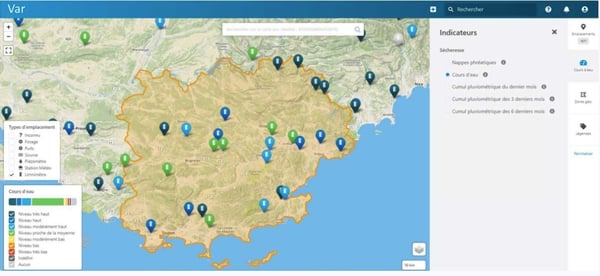The risk of drought is nothing less than a plague on humanity. Over the coming years, between 400 and 500 million people could be forced into migration simply as a result of water shortages. Fortunately, the situation in France is less critical, because we have effective drought risk mitigation solutions based on clear information, which is now shared in real time through the Info Sécheresse website.
Residents of Martinique have been subject to water supply interruptions for several months as a result of low rainfall and exceptionally high temperatures. Their experience is only one of a number of similar incidents throughout France, as increasingly frequent drought events continue to cause problems. The proliferation of invasive plants species, the increased risk of fire, problems for business, threats to food security and structural issues with buildings are just some of the additional effects already seen in France and elsewhere in the world.
From my perspective as a hydrogeologist with ImaGeau, the Saur Group specialist in active water resource management, this aspect of global warming is a new reality we will have to learn to live with. So if we do not implement solutions to mitigate the risk of drought, the world could soon be gripped by political instability, with the result that hundreds of millions of people will have no choice but to migrate.
Clear information on the risk of drought
In France, measurements of water tables and river levels are regularly taken to provide information to inform drought risk assessments. When levels and/or river flow rates fall to low levels, the Drought Committee meets. If the preset thresholds are breached, a Drought Order restricting specific uses of water may be issued for a limited time within a clearly defined area.
For local authorities, drought orders often have an economic impact. Agriculture is the first part of the local economy to be impacted, and the effects can quickly escalate to disruptions to water supplies in some areas.
Solutions are available for addressing the risk of drought
The solutions developed by experts include:
- water storage in dammed reservoirs, although this option poses issues around competition with the natural environment
- artificial refilling of water tables
- sea water desalination, although this solution requires large amounts of energy input
So although solutions to the risk of drought do exist in purely technical terms, the simpler option would appear to be the introduction of measures to save water, not only in everyday life, but also in the public domain, industrial processes and agricultural practices.
Preventive and/or corrective measures can be implemented for the most vulnerable local authorities, investment can be made to implement backup supply plans, and initiatives that promote soil infiltration capabilities and return water to the natural environment can also be considered. However, the main focus must be on maintenance programs for water abstraction and supply networks.
Using Info Sécheresse for the latest information on the risk of drought
The Info-secheresse.fr website recently made available online by ImaGeau gives everyone free access for the first time to a single tool offering the full range of information available on the risk of drought in France:
- data on groundwater levels, river flows and rainfall (soon to be joined by temperature data)
- detailed, real-time local-level data
- the statistical data necessary to assess each indicator on the basis of historical records

Close attention has been paid to ensuring that this website is convenient and easy to use. So Info-secheresse.fr should help to give everyone a clear overview of the daily drought status of France, which should facilitate the sharing of drought risk information and support decision-making at local authority level.